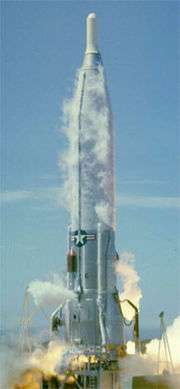Atlas I
 Launch of the maiden flight of the Atlas I, with the CRRES satellite | |
| Function | Expendable launch system |
|---|---|
| Manufacturer | Convair |
| Country of origin | United States |
| Size | |
| Height | 43.90m (144.00 ft) |
| Diameter | 3.05m (10 ft) |
| Mass | 164,300kg (362,200 lb) |
| Stages | 2.5 |
| Associated rockets | |
| Family | Atlas |
| Launch history | |
| Status | Retired |
| Launch sites | LC-36B, Cape Canaveral |
| Total launches | 11 |
| Successes | 8 |
| Failures | 3 |
| First flight | July 25, 1990 |
| Last flight | April 25, 1997 |
The Atlas I was an American expendable launch system, used in the 1990s to launch a variety of different satellites. The "I" in "Atlas I" can cause confusion, as all previous Atlas rockets were designated using letters, ending with the Atlas H, however subsequent rockets were designated using Roman numerals, starting with the Atlas II. Officially, the "I" is the Roman numeral "1". Eleven launches took place, with three failures.
Though the Atlas I was marketed as a new rocket, it was more just a re-brand of the Atlas G/H for commercial payloads, while the Atlas G and H were mostly private.
Atlas I was the last use of the classic Atlas design with three engines, jettisonable booster section, and two vernier engines, as Atlas II, while retaining most of those features, replaced the verniers with a hydrazine roll control system.
Launch history
| Date/Time (GMT) | Serial Number | Payload | Outcome | Remarks | |
|---|---|---|---|---|---|
| Atlas | Centaur | ||||
| July 25, 1990, 19:21 | AC-69 | 5049 | CRRES | Successful | Maiden flight of Atlas I, spacecraft later failed |
| April 18, 1991, 23:30 | AC-70 | 5050 | Yuri 3H | Failure | Due to management'[1] s schedule and cost pressure, engineers made a quick but wrong conclusion that One Centaur engine failed to start due to debris lodged in the LH2 turbopump. RSO destruct at T+441 seconds. The real problem was LH2 mixing with atmospheric nitrogen to form a plug of solid nitrogen in a Centaur engine valve. This resulted in the engine not developing thrust and the twin engine Centaur tumbled out of control. The problem would resurface again in Atlas AC-71. |
| March 14, 1992, 00:00 | AC-72 | 5052 | Galaxy 5 | Successful | |
| August 22, 1992, 22:40 | AC-71 | 5051 | Galaxy 1R | Failure | Centaur engine failure followed by RSO destruct. Just like the 1991 launch, this incident was caused by LH2 mixing with atmospheric nitrogen to form a plug of solid nitrogen in a Centaur engine valve. The condition was caused by an experimental procedure to increase performance by cooling the Centaur engines prior to ignition. The procedure was not fully tested under flight like conditions. This time management gave full authority to examine every possible cause until the root was found. |
| March 25, 1993, 21:38 | AC-74 | 5054 | UHF F-1 | Failure | An improperly torqued set screw caused the Atlas sustainer engine to drop to 75% thrust starting at T+25 seconds. By booster staging at T+120 seconds, sustainer thrust was down to 60%. The payload was placed in an unusable orbit. This was the last failed launch involving an Atlas vehicle. |
| September 3, 1993, 11:17 | AC-75 | 5055 | UHF F-2 (USA-95) | Successful | |
| April 13, 1994, 06:04 | AC-73 | 5053 | GOES-I (GOES-8) | Successful | |
| June 24, 1994, 13:50 | AC-76 | 5056 | UHF F-3 (USA-104) | Successful | |
| May 23, 1995, 05:52 | AC-77 | 5057 | GOES-J (GOES-9) | Successful | |
| April 30, 1996, 04:31 | AC-78 | 5058 | BeppoSAX | Successful | |
| April 25, 1997, 05:49 | AC-79 | 5059 | GOES-K (GOES-10) | Successful | Final flight of Atlas I[2] |
See also
References
- ↑ http://www.thespacereview.com/article/1321/1
- ↑ "Atlas I Successfully Launches GOES-K". International Launch Services. April 25, 1997. Retrieved March 16, 2013.
